![[graph of average cumulative number of Atlantic basin systems per year]](https://webarchive.library.unt.edu/eot2008/20080917071908im_/http://www.nhc.noaa.gov/gifs/pastprofileAT_sm.gif) Figure 1.The average cumulative number of Atlantic systems per year
Figure 1.The average cumulative number of Atlantic systems per year![[graph of average cumulative number of Eastern Pacific basin systems per year]](https://webarchive.library.unt.edu/eot2008/20080917071908im_/http://www.nhc.noaa.gov/gifs/pastprofileEP_sm.gif) Figure 2.The average cumulative number of Eastern Pacific systems per year
Figure 2.The average cumulative number of Eastern Pacific systems per year
The Atlantic hurricane season runs from June 1st to November 30th, and the Eastern Pacific hurricane season runs from May 15th to November 30th. The Atlantic basin includes the Atlantic Ocean, Caribbean Sea, and Gulf of Mexico. The Eastern Pacific basin extends to 140°W.
The following figures and tables describe the progress of a typical hurricane season in terms of the total number of tropical systems and hurricanes produced throughout the year in the Atlantic and East Pacific basins.
In the figures, curves represent the average cumulative production of all named tropical systems, all hurricanes, and those hurricanes which were Category 3 or stronger in those basins.
For example, by the beginning of September in an average year we would expect to have had four named systems, two of which would be hurricanes and one of which would be of category 3 or greater in strength.
The tables list benchmark dates when a given number of tropical systems, hurricanes, or category 3 storms should have been generated.
![[graph of average cumulative number of Atlantic basin systems per year]](https://webarchive.library.unt.edu/eot2008/20080917071908im_/http://www.nhc.noaa.gov/gifs/pastprofileAT_sm.gif) Figure 1.The average cumulative number of Atlantic systems per year
Figure 1.The average cumulative number of Atlantic systems per year |
![[graph of average cumulative number of Eastern Pacific basin systems per year]](https://webarchive.library.unt.edu/eot2008/20080917071908im_/http://www.nhc.noaa.gov/gifs/pastprofileEP_sm.gif) Figure 2.The average cumulative number of Eastern Pacific systems per year
Figure 2.The average cumulative number of Eastern Pacific systems per year
|
| Number | Named systems | Hurricanes | Category 3 or greater |
|---|---|---|---|
| 1 | July 10 | Aug 14 | Sep 3 |
| 2 | Aug 6 | Aug 30 | Sep 25 |
| 3 | Aug 20 | Sep 9 | - |
| 4 | Aug 29 | Sep 22 | - |
| 5 | Sep 5 | Oct 10 | - |
| 6 | Sep 12 | Nov 17 | - |
| 7 | Sep 20 | - | - |
| 8 | Sep 30 | - | - |
| 9 | Oct 12 | - | - |
| 10 | Nov 3 | - | - |
| Number | Named systems | Hurricanes | Category 3 or greater |
|---|---|---|---|
| 1 | June 9 | June 24 | July 19 |
| 2 | June 23 | July 13 | Aug 23 |
| 3 | July 3 | July 29 | Sep 19 |
| 4 | July 13 | Aug 12 | Oct 29 |
| 5 | July 20 | Aug 25 | - |
| 6 | July 28 | Sep 5 | - |
| 7 | Aug 5 | Sep 17 | - |
| 8 | Aug 14 | Oct 2 | - |
| 9 | Aug 21 | Oct 25 | - |
| 10 | Aug 28 | - | - |
| 11 | Sep 5 | - | - |
| 12 | Sep 13 | - | - |
| 13 | Sep 21 | - | - |
| 14 | Sep 30 | - | - |
| 15 | Oct 9 | - | - |
| 16 | Oct 27 | - | - |
The official hurricane season for the Atlantic Basin (the Atlantic Ocean, the Caribbean Sea, and the Gulf of Mexico) is from 1 June to 30 November. As seen in the graph above, the peak of the season is from mid-August to late October. However, deadly hurricanes can occur anytime in the hurricane season.
Hurricane return periods are the frequency at which a certain intensity or category of hurricane can be expected within 75 nm (86 statute miles) of a given location. In simpler terms, a return period of 20 years for a Category 3 or greater hurricane means that on average during the previous 100 years, a Category 3 or greater hurricane passed within 75 nm (86 miles) of that location about five times. We would then expect, on average, an additional five Category 3 or greater hurricanes within that radius over the next 100 years.
Our Return Periods webpage has both images and PDF documents that show the average return for Category 1, 2, 3, 4, and 5 hurricanes for selected coastal locations.
This data is produced by the National Hurricane Center Risk Analysis Program (HURISK) by Charles Neumann.
The basic idea is that a population of tropical cyclones falling within the 65 nm (75 miles) circle is
obtained from the best-track file. For that set of storms, the maximum wind within the circle is found.
Then, a count is conducted to find how many systems had winds of 30-34 kt, 35-39 kt etc. Once the count
is known, a function is used to "fit" the distribution. Since there are only a few intense tropical
cyclones typically in the 100-year record for a particular site, the mathematical function helps to
smooth this out and "fill in the holes" so to speak. The smooth function is then used to estimate the
number of systems that would occur over a longer time period. We would expect that if we actually had a
much longer historical record (several centuries) that the number of extreme events (i.e., category 5
hurricanes) observed would roughly match our estimates based on the shorter period of record.
The figures below show the zones of origin and tracks for different months during the hurricane season. These figures only depict average conditions. Hurricanes can originate in different locations and travel much different paths from the average. Nonetheless, having a sense of the general pattern can give you a better picture of the average hurricane season for your area.
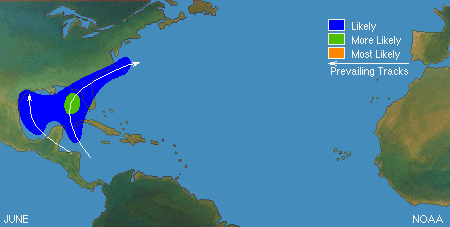
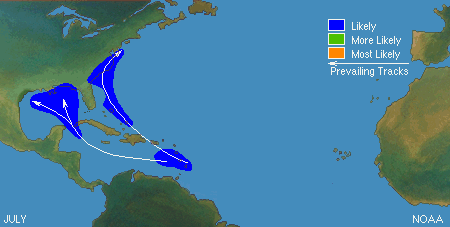
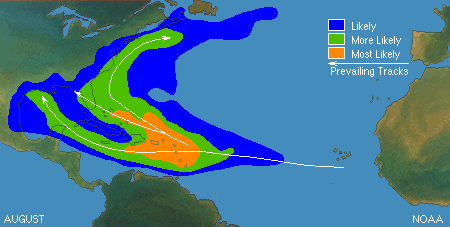
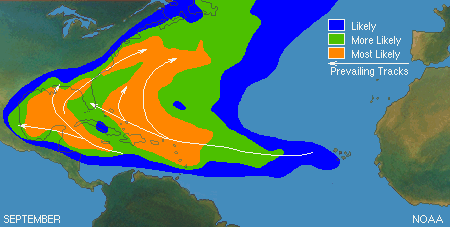
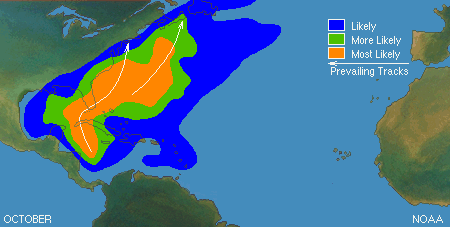

![[Tropical Cyclone History Map for Atlantic and Eastern Pacific]](https://webarchive.library.unt.edu/eot2008/20080917071908im_/http://www.nhc.noaa.gov/gifs/1851_2007_tc_sm.jpg)
![[Hurricane History Map for Atlantic and Eastern Pacific]](https://webarchive.library.unt.edu/eot2008/20080917071908im_/http://www.nhc.noaa.gov/gifs/1851_2007_hurr_sm.jpg)
![[Major Hurricane History Map for Atlantic and Eastern Pacific]](https://webarchive.library.unt.edu/eot2008/20080917071908im_/http://www.nhc.noaa.gov/gifs/1851_2007_mjrhurr_sm.jpg)
![[Graph of Tropical Cyclone Activity in the Atlantic Basin]](https://webarchive.library.unt.edu/eot2008/20080917071908im_/http://www.nhc.noaa.gov/gifs/atlhist_lowres_sm.gif)
![[Map of 1950-2007 U.S. Landfalling Hurricanes]](https://webarchive.library.unt.edu/eot2008/20080917071908im_/http://www.nhc.noaa.gov/gifs/hurr-uslandfalling-1950-2007_sm.jpg)
![[Map of 1900-2007 Hurricane Strikes by U.S. counties/parishes]](https://webarchive.library.unt.edu/eot2008/20080917071908im_/http://www.nhc.noaa.gov/gifs/strikes_us_sm.jpg)
![[Map of 1900-2007 Hurricane Strikes by U.S. counties/parishes (West Gulf)]](https://webarchive.library.unt.edu/eot2008/20080917071908im_/http://www.nhc.noaa.gov/gifs/strikes_wgulf_sm.jpg)
![[Map of 1900-2007 Hurricane Strikes by U.S. counties/parishes (East Gulf)]](https://webarchive.library.unt.edu/eot2008/20080917071908im_/http://www.nhc.noaa.gov/gifs/strikes_egulf_sm.jpg)
![[Map of 1900-2007 Hurricane Strikes by U.S. counties/parishes (Southeast)]](https://webarchive.library.unt.edu/eot2008/20080917071908im_/http://www.nhc.noaa.gov/gifs/strikes_se_sm.jpg)
![[Map of 1900-2007 Hurricane Strikes by U.S. counties/parishes (Mid-Atlantic)]](https://webarchive.library.unt.edu/eot2008/20080917071908im_/http://www.nhc.noaa.gov/gifs/strikes_midatl_sm.jpg)
![[Map of 1900-2007 Hurricane Strikes by U.S. counties/parishes (Northeast)]](https://webarchive.library.unt.edu/eot2008/20080917071908im_/http://www.nhc.noaa.gov/gifs/strikes_ne_sm.jpg)
Colin McAdie
Get Storm Info
Satellite Imagery -
US Weather Radar -
Aircraft Recon -
Advisory Archive -
Mobile Products -
E-Mail Advisories -
RSS Feeds -
About NHC Products
Tropical Analysis and Forecasting
Atlantic Products -
E Pac Products -
About TAFB Products
Learn About Hurricanes
Hurricane Awareness -
Frequently Asked Questions -
AOML Hurricane-Research Division -
Hurricane Hunters -
The Saffir-Simpson-Hurricane Scale -
Forecasting Models -
Inland Wind Model -
Eyewall Wind-Profiles -
TPC Glossary -
TPC Acronyms -
Storm Names
Breakpoints
Hurricane History
NHC/TPC Archives -
Forecast Verification -
Climatology -
1492-1996 (Atlantic) -
1900-2000 (USA) -
Most Expensive -
Most Intense -
US Strikes by Decade -
US Strikes by State
About Us
About the TPC -
Mission/Vision -
Other NCEP Centers -
TPC Personnel -
NOAA Locator -
Visitor Information -
NHC Library -
WX4NHC Amateur Radio Station
NOAA/
National Weather Service
National Centers for Environmental Prediction
National Hurricane Center
Tropical Prediction Center
11691 SW 17th Street
Miami, Florida, 33165-2149 USA
nhcwebmaster@noaa.gov
Disclaimer
Privacy Policy
Credits
About Us
Glossary
Career Opportunities
Page last modified: Wednesday, 14-May-2008 14:18:14 GMT